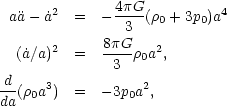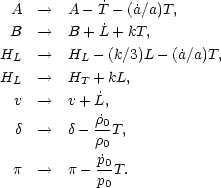


3.1. Linear perturbations
For simplicity, in the following discussion we will restrict attention
to the case of an Einstein-de Sitter (k = 0) model composed of
radiation, considered as a perfect fluid with an equation of state
p = 1/3
 c2, together with a pressureless baryon fluid. These
conditions
are easily relaxed but represent an adequate approximation to the
standard hot big bang models during the radiation era and whilst
perturbations on scales corresponding to galaxies and galaxy clusters
are larger than the particle horizon.
c2, together with a pressureless baryon fluid. These
conditions
are easily relaxed but represent an adequate approximation to the
standard hot big bang models during the radiation era and whilst
perturbations on scales corresponding to galaxies and galaxy clusters
are larger than the particle horizon.
The unperturbed metric may be written as (6)
 |
(3.1) |
and the unperturbed energy momentum tensor
 |
(3.2) |
where p0 is the unperturbed pressure and
 0 is
the unperturbed
energy density and the four velocity uµ has
components
0 is
the unperturbed
energy density and the four velocity uµ has
components
 |
(3.3) |
The scale factor a( )
is related to p0 and
)
is related to p0 and
 0 by
the usual Friedmann equations
(Weinberg, 1972,
Section 15),
0 by
the usual Friedmann equations
(Weinberg, 1972,
Section 15),
 |
(3.4a) (3.4b) (3.4c) |
where a dot denotes a derivative with respect to
 . In addition, let
. In addition, let
 |
(3.5) |
Now, consider the perturbed metric,
 |
(3.6) |
where the perturbations are assumed to be small
| hµ |
<<
a2(
|
<<
a2( ).
Since the
hµ
).
Since the
hµ are
not physically measurable quantities one may make an
infinitesimal coordinate transformation,
are
not physically measurable quantities one may make an
infinitesimal coordinate transformation,
 |
(3.7) |
to find an equally valid solution
 |
(3.8) |
(Weinberg, 1972,
Section 15.10). The ability to add terms to
hµ which
correspond merely to infinitesimal (gauge) transformations has led to
some problems in the interpretation of the results of the perturbation
calculations. In particular since the quantity of most interest, the
fractional change in energy density
which
correspond merely to infinitesimal (gauge) transformations has led to
some problems in the interpretation of the results of the perturbation
calculations. In particular since the quantity of most interest, the
fractional change in energy density
 =
=

 /
/
 0, is
not a gauge invariant quantity, various results for the growth rates of
0, is
not a gauge invariant quantity, various results for the growth rates of
 may be
found in the literature
(Lifshitz, 1946;
Harrison, 1967;
Silk, 1968;
Sakai, 1969;
Peebles, 1980a).
This need not be a problem, however,
since with sufficient care fictitious "gauge mode" solutions may be
eliminated
(Press and Vishniac,
1980a).
An independent and interesting
approach to the problem has recently been presented by
Bardeen (1980).
Following earlier work of
Hawking (1966) and
Olson (1976),
Bardeen discusses a formalism in which the time development of
gauge-invariant measures of small perturbations to the homogeneous
background may be followed.
may be
found in the literature
(Lifshitz, 1946;
Harrison, 1967;
Silk, 1968;
Sakai, 1969;
Peebles, 1980a).
This need not be a problem, however,
since with sufficient care fictitious "gauge mode" solutions may be
eliminated
(Press and Vishniac,
1980a).
An independent and interesting
approach to the problem has recently been presented by
Bardeen (1980).
Following earlier work of
Hawking (1966) and
Olson (1976),
Bardeen discusses a formalism in which the time development of
gauge-invariant measures of small perturbations to the homogeneous
background may be followed.
We shall discuss the case of a scalar (i.e. density) plane-wave perturbation (Lifshitz and Khalatnikov, 1963), in which
 |
(3.9a) (3.9b) (3.9c) |
where
 |
(3.10) |
and k is the comoving wave vector. The four-velocity may be written,
 |
(3.11a) |
with
 |
(3.11b) |
where (3.11b) results from the normalization condition uµuµ = - 1. The perturbed energy-momentum tensor may be written,
 |
(3.12a) (3.12b) (3.12c) (3.12d) |
We can now investigate the way in which the perturbation amplitudes in Eqs. (3.8)-(3.11) change under a coordinate transformation. Since the perturbation analysis is only to first order, only the first order effects of the transformation need be considered. The most general coordinate transformation may be written [Eq. (3.7)],
 |
(3.13a) (3.13b) |
Hence the perturbation amplitudes transform as (Weinberg, 1972, Section 10.9; Bardeen, 1980),
 |
(3.14a) (3.14b) (3.14c (3.14d) (3.14e) (3.14f) (3.14g) |
The amplitudes in Eqs. (3.14) may be combined to produce gauge invariant amplitudes. For example, one of the quantities considered by Bardeen,
 |
(3.15) |
is clearly gauge invariant by Eqs. (3.14b, e, f). The quantity
 m is
equal to
m is
equal to  in a gauge in
which v = B, i.e. if the matter worldlines
are orthogonal to the hypersurface of constant time
in a gauge in
which v = B, i.e. if the matter worldlines
are orthogonal to the hypersurface of constant time
 . Even in a
gauge-invariant formalism there remains some ambiguity since one can
define various gauge-invariant quantities like
. Even in a
gauge-invariant formalism there remains some ambiguity since one can
define various gauge-invariant quantities like
 m
which may be
interpreted as
m
which may be
interpreted as  by some
appropriate choice of hypersurface of
simultaneity. In practice, for a sensible choice of hypersurface, the
ambiguity disappears once the perturbation is well within the horizon,
hence
by some
appropriate choice of hypersurface of
simultaneity. In practice, for a sensible choice of hypersurface, the
ambiguity disappears once the perturbation is well within the horizon,
hence  m
m

 for
k
for
k >> 1. The
motivation behind Bardeen's discussion of
>> 1. The
motivation behind Bardeen's discussion of
 m
is that the equations governing its time evolution are particularly simple.
m
is that the equations governing its time evolution are particularly simple.
If the entropy per baryon is constant (adiabatic fluctuations), then [Eqs. (3.5)]
 |
(3.16) |
and w =
cs2
=
cs2
 . It is also interesting
to include "entropy" perturbations, i.e.
. It is also interesting
to include "entropy" perturbations, i.e.

 R /
R /
 R
R
 4/3
4/3

 B /
B /
 B.
This may be done by considering the amplitude.
B.
This may be done by considering the amplitude.
 |
(3.17) |
which is gauge invariant by Eqs. (3.14f, g). Bardeen derives the
equation governing the time evolution of
 m
which, in the radiation era when
w
m
which, in the radiation era when
w  cs2
cs2
 1/3 takes the
simple form,
1/3 takes the
simple form,
 |
(3.18) |
Ignoring the source term
 (
( ), it can be seen that the
solutions to
Eq. (3.18) will show oscillatory behavior on scales smaller than the
horizon (k
), it can be seen that the
solutions to
Eq. (3.18) will show oscillatory behavior on scales smaller than the
horizon (k >> 1)
>> 1)
 m
m
 exp(ik
exp(ik /
31/2) and power law behaviour,
/
31/2) and power law behaviour,
 m =
fg
m =
fg
 2 +
fd
2 +
fd
 -1 on scales
greater than the horizon. These results agree with those obtained by
Sakai (1969)
using the comoving gauge (ui = h0i = 0)
but differ from the growth rates obtained using the synchronous gauge
(h00 = h0i = 0,
Weinberg, 1972;
Peebles, 1980a;
Press and Vishniac, 1980a).
These authors find solutions,
-1 on scales
greater than the horizon. These results agree with those obtained by
Sakai (1969)
using the comoving gauge (ui = h0i = 0)
but differ from the growth rates obtained using the synchronous gauge
(h00 = h0i = 0,
Weinberg, 1972;
Peebles, 1980a;
Press and Vishniac, 1980a).
These authors find solutions,
 = fg1
= fg1
 2 +
fg2
2 +
fg2  +
fd
+
fd
 -2 for
perturbations with
k
-2 for
perturbations with
k << 1. The
decaying mode fd
<< 1. The
decaying mode fd
 -2 has
no physical significance since it may be eliminated by adjusting the initial
hyper-surface of constant time (see Press and Vishniac). On scales
smaller than the horizon, the synchronous gauge gives
-2 has
no physical significance since it may be eliminated by adjusting the initial
hyper-surface of constant time (see Press and Vishniac). On scales
smaller than the horizon, the synchronous gauge gives

 exp[ik
exp[ik / 31/2]
which agrees with the behaviour of
/ 31/2]
which agrees with the behaviour of
 m
for k
m
for k >> 1.
>> 1.
Now consider the term
 (
( ), this acts as a source term in
Eq. (3.18) and one might speculate that a non-zero
), this acts as a source term in
Eq. (3.18) and one might speculate that a non-zero
 (
( ) might generate fluctuations in
) might generate fluctuations in
 m.
Consider for example, the case in which some of the
matter is suddenly converted into a pressureless form, perhaps black
holes. This will generate a pressure inhomogeneity
(Meszaros, 1975:
Carr, 1977),
m.
Consider for example, the case in which some of the
matter is suddenly converted into a pressureless form, perhaps black
holes. This will generate a pressure inhomogeneity
(Meszaros, 1975:
Carr, 1977),
 |
(3.19) |
but we can see from Eq. (3.18) that the induced
 m
will be of order ~ k2
m
will be of order ~ k2
 2
2
 (
( )
and is due to pressure gradients transmitted at the sound
speed. Thus if the perturbation comes within the horizon during the
radiation era,
)
and is due to pressure gradients transmitted at the sound
speed. Thus if the perturbation comes within the horizon during the
radiation era,
 m
m

 (
( ). This result is
discussed in more detail by
Press and Vishniac
(1980a)
who show that it is also true for perturbations which enter the horizon
during the matter-dominated era, and by
Bardeen (1980)
who also considers the possible role of
anisotropic stress perturbations. Their results lead to an important
conclusion concerning the possibility of spontaneously forming density
perturbations at early times which we discuss below.
). This result is
discussed in more detail by
Press and Vishniac
(1980a)
who show that it is also true for perturbations which enter the horizon
during the matter-dominated era, and by
Bardeen (1980)
who also considers the possible role of
anisotropic stress perturbations. Their results lead to an important
conclusion concerning the possibility of spontaneously forming density
perturbations at early times which we discuss below.
6 Here, Greek indices run from 0 to 3 whilst Latin indices run from 1 to 3 and covariant derivatives will be denoted by a semi-colon. Units are chosen so that c = 1. Back.